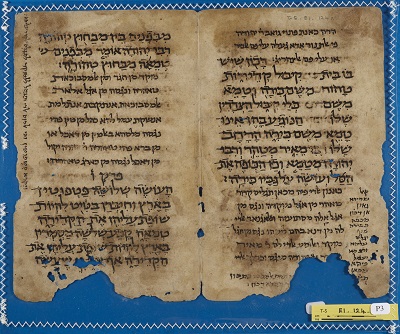Mishnah with Judeo-Arabic Translation: T-S E1.124
Translations of the Bible into the vernacular language of the Jews of the Genizah world, Arabic, are widely known and preserved in hundreds, if not thousands, of manuscript copies. Less well-known, and less frequently found, are translations of important rabbinic texts. T.-S. E1.124 (one page of it pictured below) is part of the Mishnaic tractate Kelim, with a translation in Judeo-Arabic interspersed every few lines. Jacob N. Epstein published this and another related fragment in 1950. As he pointed out, the translation demonstrates that the Mishnah was being studied by people who needed a version in their daily language. The format reminds us of modern-day Loeb editions of Greek and Latin texts, with Greek or Latin on the left-hand pages facing English versions on the right. Epstein argued that the presence here of passages from two tractates, Eduyot and Kelim, shows that in all likelihood the entire Mishnah was translated in the manuscript from which these pages come.
Epstein was not able to give the fragments the full study they demanded “because of the state of emergency” of the Israeli War of Independence raging round him in Jerusalem at the time. He never returned to the subject. Since then, however, several more fragments from what seems to be the same manuscript have turned up in the Genizah, all in Cambridge. They include passages from Gittin, Sanhedrin, Avodah Zarah and Avot. The spread of passages, from six tractates in all, across three of the six orders in the Mishnah provides additional support for Epstein’s belief that the entire Mishnah was included in this manuscript.
These are not the only fragments of Judeo-Arabic versions of Mishnaic tractates, but they all come from a single manuscript and for that reason may have much more to tell us than we might learn from isolated fragments of other manuscripts. On the basis of the pages we have, we can do much to re-construct the shape and appearance of the original manuscript. We can also compute that the entire Mishnah, with its translation, in this single manuscript must have filled nearly 6,000 pages, making for an enormous and, in view of the thickness of the paper, unwieldy, multi-volume copy of the text.
Given the costs of manuscript production, even this fairly elementary study aid must have been an expensive item. Was it made for an individual or for a yeshiva or a community? Its creation testifies to the interest and devotion to learning of the Jews at that time, as well as to the generosity of the patron who probably paid for it.
When and where was the manuscript produced? Epstein assigned it to the tenth or eleventh century, suggesting that it was copied in north Africa or Spain, with what looked like a preference for Spain reflecting the magnificence of the Golden Age. More recently, however, Edna Engel, of the Hebrew Palaeography Project at the National Library of Israel in Jerusalem, has suggested a later date, and that in its turn may hint rather at a north African provenance.
Epstein also connected the translation in this manuscript with the report, found in the Sefer ha-Qabbalah of Abraham ibn Daud, that Rabbi Joseph Ibn Abitur “interpreted the whole of the Talmud in Arabic for the Muslim King al-Hakam” (reigned 961-976) in Cordoba. Years ago, I was able to tie that report to a Muslim acquaintance also in Cordoba with the tractate Avot in that same tenth century. These testimonies, however, suggest a distinct version, in Arabic, not in Judeo-Arabic. Whether and if so how these two sets of translation, into Judeo-Arabic for a study audience of Jews and into Arabic for a Muslim audience, are related needs further investigation.
Thanks to Melonie Schmierer-Lee, Curator – Discarded History: The Genizah of Medieval Cairo and Research Associate at the Genizah Research Unit, who alerted me to some of the other fragments, I have been able to begin preparing all these fragments for combined publication. I am looking at their possible contributions to our knowledge of the Mishnaic text, at the language of the translation and at the musical notation that they, like a number of other medieval, especially Mishnaic, manuscripts, carry. However, I am also interested in the larger context that called forth this and other manuscripts like it. I hope that publication of these fragments will make it possible to identify further fragments, both from this manuscript and from other such translations in collections of Genizah materials around the world.
David J. Wasserstein is professor of history and holds the Eugene Greener, Jr. Chair in Jewish Studies at Vanderbilt University.
Cite this article
(2018). Mishnah with Judeo-Arabic Translation: T-S E1.124. [Genizah Research Unit, Fragment of the Month, May 2018]. https://doi.org/10.17863/CAM.34052
If you enjoyed this Fragment of the Month, you can find others here.
Contact us: genizah@lib.cam.ac.uk
The zoomable images are produced using Cloud Zoom, a jQueryimage zoom plugin:
Cloud Zoom, Copyright (c) 2010, R Cecco, www.professorcloud.com
Licensed under the MIT License

